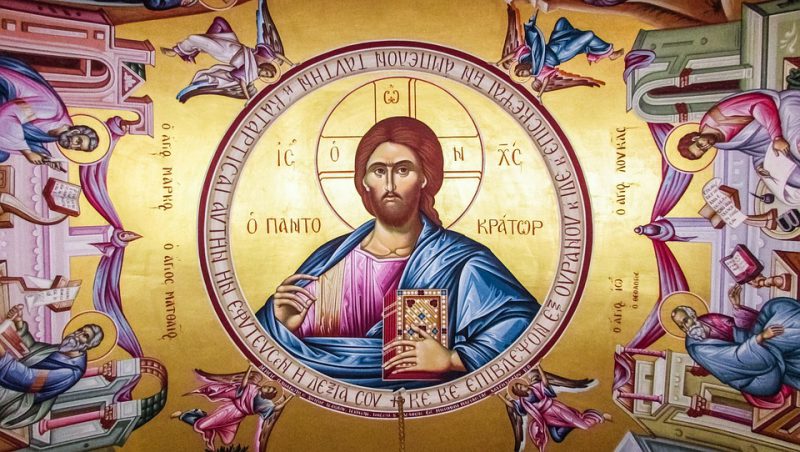Perhaps one of the most controversial spiritual practices in the Eastern Orthodox Church – aside from veneration of the Theotokos and intercessory prayer to the Saints – is the presence and veneration of holy icons. In most Orthodox churches, you will see countless icons on the walls and ceilings. The parish will also usually have a few icons on stands in the church you can approach and kiss. But why do Orthodox churches have icons in the first place, and why do we kiss them? Isn’t that idolatry?
0 minutes
What are icons?
Icons are pictorial representations of Biblical scenes from the life of Jesus Christ, historical events in the life of the Church, and portraits of the Saints. They are usually two-dimensional images that can be made of paint, mosaic, embroidery, carving, engraving, or other methods.

These holy images preserve the doctrinal teachings of the Church. In other words, they declare what we believe in the universal language only an image can successfully speak. As such, they are an integral part of Orthodox faith and spiritual life. They have a sacramental character, making present to the believer the person or event depicted on them. The icon connects with and speaks to us, preaches to us in its depiction, teaches us, illumines us, and assists us to imitate the Saints and God.
No “graven” image?
It is easy to see why most Protestants would mistakenly think icons might be idols. After all, the second commandment tells us not to make any “graven (sometimes translated, “carved”) image, or any likeness of any thing that is in heaven above, or that is in the earth beneath, or that is in the water under the earth; you shall not bow down to them nor serve them” (Exodus 20:4-5). It sounds rather straightforward. However, a few chapters later, God tells His people to make images of cherubim and place them over the Ark of the Covenant (Exodus 27:17-20). So, which is it?
Related: Top 10 Online Orthodox Icon Shops
Clearly, God makes a distinction between the proper and improper use of holy images here. Thus, we can see it is not the image itself that is idolatrous, but the misuse of that image. The worshiping of that image, serving it as though it were God. That is what causes someone to fall into idolatry.
Veneration is not worship
Like the cloak of Jesus that healed the woman with an issue of blood, these icons convey the grace of God as He wills it. However, they are not divine beings. Thus, we do not worship them, nor do we worship the person(s) depicted within them. Instead, we venerate them. Veneration (σεβασμός) is a reverence (ευλάβεια), honor of love, or recognition paid to all those portrayed in an icon. Many people in the West often misinterpret veneration as worship; however, worship (προσκύνησης, total devotion of the self) in the Eastern Orthodox Church is reserved for God alone.
Read More: Sunday Of The Triumph Of Orthodoxy
A mother who misses her son may carry his picture in her purse. Sometimes she might take it out to kiss it. But this woman is not worshiping that picture. Nor is she so confused as to believe that picture is actually her son. And so it is with icons.
Why the Orthodox kiss and venerate holy icons
As St. John Damascene says, “I do not venerate matter, I venerate the fashioner of matter, who became matter for my sake, and in matter made his abode, and through matter worked my salvation.”
Orthodox Christians kiss icons and bow before them because Christ entered the world and made Himself a part of it; and that world He entered is good and holy. In this way, icons serve as windows into heaven, showing us the glory of Christ.
Read On: Why Orthodox Christians Venerate Relics
Moreover, we venerate icons with the understanding that veneration is not paid to the material object itself, but to the person or event represented in that icon “in spirit and truth” (John 4: 24). The veneration given to the icon passes over, as Saint Basil says, to its prototype, causing those who look at them to commemorate and love and respect that person or event.
We kiss icons to express our love!
Contrary to what most people believe, we do not worship the icons, but instead venerate (or pay respect) to them. Orthodox Christians kiss icons to show those depicted in them the love we have for them. Not only that, but it also conveys to them the honor they should receive for being icons of Christ, shining examples for us that teach us how to live the Christian life.
Keep Reading: 8 Things To Expect In An Orthodox Church

2 Responses
What I don’t understand is why it is “mandatory” for us to venerate the icon. If it is meant as an expression of love, why does the church make it a mandatory expression?
Is there a reference in the bile to where we’re supposed to venerate in the first place?
Paula,
Christ is Risen! We will answer your question with another question, if that’s all right. If it is meant as an expression of love to obey the commandments, why is it “mandatory”? Or why is it considered “mandatory” to worship our Lord and God and Savior Jesus Christ, when that, too, is an expression of love? We would also ask why you feel something needs to be written down to be a legitimate practice in the life of the Church. There is an incredibly rich history of Christian practices that were preserved orally, safeguarded by the Holy Spirit. Of course, we ask this in love to help you critically assess your position on this, not out of derision or a desire to debate. God bless!